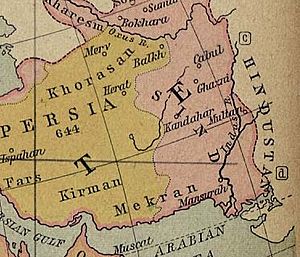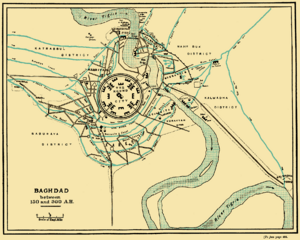- This page was last modified on 17 October 2025, at 10:18. Suggest an edit.
al-Mansur facts for kids
For other uses, see Al-Mansur (disambiguation).
| al-Mansur المنصور |
|||||
|---|---|---|---|---|---|
| Caliph Commander of the Faithful |
|||||
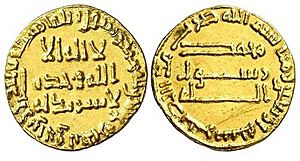
Gold dinar of al-Mansur
|
|||||
| 2nd Caliph of the Abbasid Caliphate | |||||
| Reign | 10 June 754 – 6 October 775 | ||||
| Predecessor | al-Saffah | ||||
| Successor | al-Mahdi | ||||
| Born | c. 714 al-Humayma, Jordan |
||||
| Died | 6 October 775 (aged 61) near Mecca, Saudi Arabia]] |
||||
| Burial | al-Ma'lat Cemetery | ||||
| Spouse |
|
||||
| Issue | |||||
|
|||||
| Dynasty | Abbasid | ||||
| Father | Muhammad ibn Ali | ||||
| Mother | Sallamah | ||||
| Religion | Sunni Islam | ||||
Al-Mansur, whose full name was Abu Ja'far Abd Allah ibn Muhammad al-Mansur, was a very important leader in Islamic history. He was the second Abbasid caliph, ruling from 754 CE to 775 CE. He took over after his brother, al-Saffah.
Al-Mansur is famous for starting the 'Round City' of Madinat al-Salam. This city later became the heart of the great city of Baghdad. Many historians believe al-Mansur was the true founder of the Abbasid Caliphate. He helped make the dynasty strong and organized, creating one of the largest empires in world history.
Contents
Early Life and Rise to Power
Where Al-Mansur Grew Up
Al-Mansur was born around 714 CE in Humeima, which is in modern-day Jordan. His family, the Abbasids, had moved there from another region. His mother was named Sallamah, and she was a Berber woman.
Al-Mansur was the brother of al-Saffah, who became the first Abbasid caliph. Both brothers were named Abd Allah. To tell them apart, al-Saffah was called Abu al-Abbas.
Family Background and the Abbasid Revolution
Al-Mansur was a great-grandson of Abbas ibn Abd al-Muttalib. Abbas was an uncle of the Islamic prophet, Muhammad. This family connection was very important.
In the 740s, al-Mansur's brother, al-Saffah, began to claim he should be the caliph. He was especially active in Khorasan, a region where many non-Arab Muslims lived. After the Umayyad caliph Hisham ibn Abd al-Malik died in 743, there was a lot of unrest.
Al-Saffah led the Abbasid Revolution in 747. Many Muslims in Iraq supported his claim to power. In 750, he became the first caliph of the Abbasid Caliphate after defeating his rivals.
Joining the Abbasid Movement
Before the Umayyad Caliphate was overthrown, the last Umayyad Caliph, Marwan II, arrested al-Mansur's brother, Ibrahim. Al-Mansur and his family fled to Kufa. There, some rebel leaders from Khorasan pledged their loyalty to al-Saffah.
Ibrahim died while imprisoned, and al-Saffah became the first Abbasid Caliph. During his brother's rule, al-Mansur led an army into Mesopotamia. He received the surrender of a governor there. This governor had hidden in a garrison town in Iraq. Al-Mansur and al-Saffah promised him safety, but after he surrendered, he was executed.
Al-Mansur's Reign as Caliph
Becoming the Caliph
Al-Saffah ruled for only five years before he died. Al-Mansur then took on the huge task of leading the Abbasid Caliphate. He ruled for almost 22 years, from 754 to 775 CE.
Al-Mansur was declared Caliph in 753 while on his way to Mecca. He officially took power the next year. He chose the name al-Mansur, which means "the victorious." He also agreed that his nephew, Isa ibn Musa, would be his successor. This agreement was meant to prevent family rivalries.
Dealing with Challenges
However, al-Mansur's right to be caliph was challenged by his uncle, Abdullah ibn Ali. Once al-Mansur was in power, he had his uncle imprisoned in 754. His uncle was later killed in 764.
Al-Mansur also faced challenges from powerful generals. He was worried about the popular Abbasid army general, Abu Muslim. Abu Muslim had become very popular among the people. Al-Mansur carefully planned to remove him. While Abu Muslim was talking with the Caliph, guards rushed in and killed the general.
This event caused anger in the province of Khorasan. In 755, an Iranian nobleman named Sunpadh led a revolt against al-Mansur. He captured several cities and gained many supporters. Al-Mansur sent a large army to stop the rebellion. Sunpadh was defeated, and Khorasan was brought back under Abbasid control.
Building Baghdad: The Round City
To make his power stronger, al-Mansur decided to build a brand new capital city. This city was called Madinat as-Salam, which means "the city of peace." It later became the famous city of Baghdad.
Al-Mansur started building Baghdad in 762 CE. He chose a spot on the western bank of the Tigris River. The city was designed in a circular shape, about 2.4 kilometers (1.5 miles) across. It had a strong double wall for defense and four main gates.
In the very center of the city, al-Mansur built his palace and the main mosque. He built Baghdad because he wanted a stable capital for his growing empire. The new city also helped house and support the many officials in the Abbasid government.
Baghdad: A Center of Learning
Al-Mansur wanted a powerful, central government in Baghdad. The city quickly became home to people of many different faiths and cultures from all over the Islamic world. This included Christians, Zoroastrians, and Jewish people.
Al-Mansur focused on making Islam stronger by hiring Muslims from various backgrounds to work in his government. Baghdad became one of his greatest achievements. His rule was mostly peaceful, and he worked on improving the empire from within. He supported farming and encouraged the growth of sciences. This laid the groundwork for Baghdad to become a global center for learning and science in the future.
Succession and Wise Sayings
In 764, al-Mansur named his son, al-Mahdi, as the next caliph. This meant al-Mahdi would take over instead of al-Mansur's nephew, Isa ibn Musa, who was originally chosen. This change was supported by the Abbasid army.
Al-Mansur was known for being very knowledgeable about his empire. He had a secret service that kept him informed about everything, even the price of figs! He worked hard from dawn until evening prayer. He told his son, "Do not put off today's work until tomorrow." He also advised him to "attend in person to the affairs of state."
Al-Mansur was also very careful with money. He was nicknamed "the Father of Small Change" because he watched his tax collectors closely. He made sure that public spending was carefully managed. He believed that "he who has no money has no men."
Scholars and Knowledge Under Al-Mansur
Supporting Islamic Scholars
Al-Mansur was the first Abbasid caliph to make Islamic teachings a public policy. He encouraged proper worship, for example, by organizing pilgrim caravans.
Some groups, like the Alids (descendants of Muhammad's cousin Ali), had helped the Abbasids fight the Umayyads. They wanted power to go to Imam Ja'far al-Sadiq, a respected scholar. When it became clear the Abbasids would not give power to an Alid, these groups became opponents. Al-Mansur took action against those he saw as extreme.
Imam Ja'far al-Sadiq faced difficulties from the Abbasid family. Because he was so popular, he was eventually poisoned on the caliph's orders. Other important scholars, like Abu Hanifa an-Nu'man, were imprisoned.
Encouraging Translations and Learning
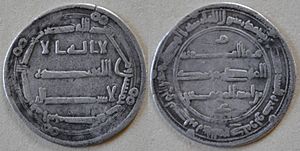
Abbasid Silver Dirham of Caliph al-Mansur 754–775
Al-Mansur was the first Abbasid caliph to actively support the Translation Movement. He was especially interested in getting texts about astronomy and astrology translated. He invited scientists to his court.
When an Indian astronomy book called Zij al-Sindhind was brought to his court, al-Mansur ordered it to be translated from Sanskrit into Arabic. The astronomical tables in this translation became very popular among Muslim scholars. During his rule, Greek works like Ptolemy's Almagest and Euclid's Elements were also translated.
Al-Mansur also had Persian books on astronomy, math, medicine, and philosophy translated. This was part of a growing interest in ancient Iranian culture. He paid close attention to the quality of these translations. For example, he paid for Euclid's Elements to be translated twice. He also supported the translation of medical books by famous Greek doctors like Galen and Hippocrates.
In 765, al-Mansur had a stomach illness. He called a Christian doctor named Jurjis ibn Bukhtishu from Gundeshapur to Baghdad for treatment. This started a tradition where Abbasid caliphs would hire doctors from the Bukhtishu family. These doctors would also write their own medical books and translate others into Arabic.
Foreign Relations
Relations with China
In 751, the first Abbasid caliph, al-Saffah, had defeated the Chinese Tang dynasty in the Battle of Talas. Chinese records show that al-Mansur regularly sent diplomatic groups to China. These groups were known in China as Heiyi Dashi, meaning "Black Clothed Arabs."
In 756, al-Mansur even sent 3,000 soldiers to help the Chinese Emperor Xuanzong of Tang during a rebellion.
Dealing with the Byzantine Empire
The Byzantine emperor Constantine V had taken advantage of the Umayyad Caliphate's weakness to regain land from Muslim rulers. After al-Mansur's brother defeated the Umayyads, Constantine V invaded Armenia.
Under al-Mansur's rule, Muslim armies launched attacks on Byzantine lands. Al-Mansur was the first Abbasid caliph to arrange a prisoner exchange with the Byzantine Empire. Diplomats from both sides negotiated this exchange in 756.
Expansion and Alliances
In 763, al-Mansur sent his troops to conquer al-Andalus (modern-day Spain) for the Abbasid Empire. However, the Umayyad caliph Abd al-Rahman I successfully defended his territory. Al-Mansur then pulled back his troops and focused on holding the eastern parts of his empire, which were once part of Persia.
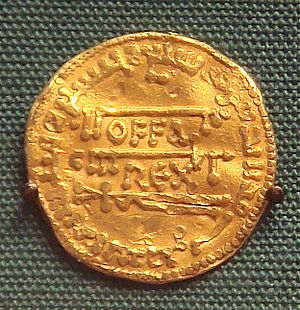
A mancus issued under the Saxon king Offa of Mercia (757–796), copied from a gold dinar of al-Mansur's reign. It combines the Latin legend OFFA REX with Arabic legends. The date of A.H. 157 (773–774) is readable. British Museum.
Some historians believe al-Mansur started the alliance between the Abbasids and the Carolingian kings in Europe. In 765, the Carolingian king Pippin III sent diplomats to al-Mansur's court in Baghdad. Pippin III likely wanted an alliance with al-Mansur against their common enemies. In 768, Pippin III's envoys returned to Francia with al-Mansur's ambassadors. Gifts were exchanged, showing the new alliance. This alliance became even stronger later between King Charlemagne and Caliph Harun al-Rashid.
Family Life
Al-Mansur had several wives and concubines. His first wife was Arwa, also known as Umm Musa. She came from a royal family in Yemen. They had two sons, Muhammad (who would become Caliph al-Mahdi) and Ja'far. Arwa died in 764.
Another wife was Hammadah, who was al-Mansur's cousin. She died during his rule. He also married Fatimah, who had three sons: Sulayman, Isa, and Ya'qub.
Al-Mansur also had several concubines, including a Kurdish woman and a Greek woman. His only daughter, Aliyah, was born to an Umayyad woman.
Death and Legacy
Al-Mansur died on October 6, 775 CE. He was on a pilgrimage to Mecca when he passed away. He was about 61 years old.
There are different stories about where he died. One story says he died near Mecca, and 100 graves were dug around Mecca to prevent anyone from finding his actual burial place. Another story says he died near a well called Maimun.
When al-Mansur died, the caliphate's treasury was very rich, holding a huge amount of money. On his deathbed, he reportedly said, "We have sacrificed the life to come for a mere dream!"
Al-Mansur's rule was crucial for the Abbasid Caliphate. He brought stability, built a new capital, and encouraged learning and science. His actions helped set the stage for a golden age of Islamic civilization.
Images for kids
-
Abbasid Silver Dirham of Caliph al-Mansur 754–775
-
A mancus issued under the Saxon king Offa of Mercia (757–796), copied from a gold dinar of al-Mansur's reign. It combines the Latin legend OFFA REX with Arabic legends. The date of A.H. 157 (773–774) is readable. British Museum.
See also
 In Spanish: Al-Mansur para niños
In Spanish: Al-Mansur para niños
- al-Rumiya, city used temporarily by al-Mansur as his seat
- Bay'ah Mosque is a mosque outside Mecca in Arabia, It was built on the orders of al-Mansur.
- Hasan ibn Zayd ibn Hasan Abbasid Governor of Medina 766 to 772.
- Ibn Ishaq
- Sino-Arab relations

